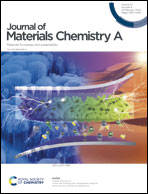Ultra-low thermal conductivity in B2O3 composited SiGe bulk with enhanced thermoelectric performance at medium temperature region†
Abstract
Commonly, SiGe is considered as a typical thermoelectric material with a favorable performance in the high temperature region. Here, we report a new strategy through the addition of the nano-second-phase B2O3 into SiGe via ball milling and spark plasma sintering technique, aiming to realize high thermoelectric performance in the medium temperature region. By controlling the amount of B2O3 added to the SiGe matrix, the thermal conductivity is greatly reduced because of the compound effects of the nano-second-phase and beneficial microstructure. Simultaneously, the power factors are also enhanced, resulting in a high ZT of 1.47 of the p-type B2O3/SiGe bulk composite at 873 K. Our ZT values are 116% higher than the typical materials used in radio-isotope thermoelectric generators (RTGs), and show 104% enhancement over the p-type SiGe alloys in the present study. This study opens a new way to widen and improve the thermoelectric performance for narrow temperature region materials, and is especially highly effective for the environmentally friendly SiGe materials.



 Please wait while we load your content...
Please wait while we load your content...